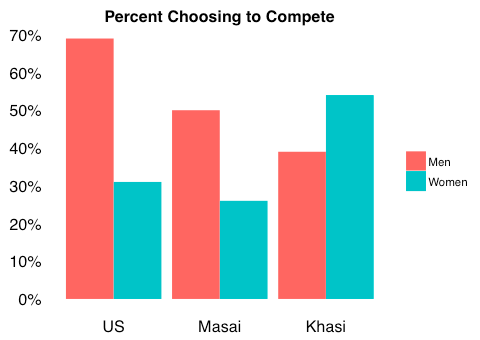What Can a Ball and a Bucket Teach Us About Why Women Earn Less Than Men?
 John List and Uri Gneezy have appeared on our blog many times. Now they have written a book, The Why Axis: Hidden Motives and the Undiscovered Economics of Everyday Life. (The title, by the way, was crowdsourced on this blog). Below is the first in a series of guest posts adapted from the book; Gneezy spoke about this research in our podcast “Women Are Not Men.”
John List and Uri Gneezy have appeared on our blog many times. Now they have written a book, The Why Axis: Hidden Motives and the Undiscovered Economics of Everyday Life. (The title, by the way, was crowdsourced on this blog). Below is the first in a series of guest posts adapted from the book; Gneezy spoke about this research in our podcast “Women Are Not Men.”
What can a Ball and Bucket Teach Us About Why Women Earn Less than Men?
By Uri Gneezy and John List
The sign on the road leading to the city of Shilong in the Khasi hills of northeast India had a puzzling message: “Equitable distribution of self-acquired property rights.” Later we’d find out that the sign was part of a nascent men’s movement, as the men in the Khasi society were not allowed to own property. We’d traveled across the world in search of such a parallel universe—one where men felt like “breeding bulls and babysitters”—because evidence in the U.S. was starting to point to a massive gap in preferences towards competition between the genders and we wanted to understand the reason why.
Our plan was to take a simple game to a matrilineal society (the Khasi) and patrilineal society (the Masai in Tanzania) and give participants just one choice: Earn a small certain payment for their performance in the game or earn a much bigger payment for their performance, but only if they also bested a randomly chosen competitor. The game we settled on? Tossing tennis balls into a bucket 3 meters away. The experiment was conducted with Kenneth Leonard as a coauthor.
First, though, we headed to the plains below Kilimanjaro, the tallest mountain in Africa, where the proud Masai tribesman lived. The Masai, dressed in brightly colored robes and carrying their spears, follow the calling of their cattle-hearing ancestors. The more cattle a man has there, the more wealth he possesses. A man’s cows are more important to a Masai man than his wives and a cattle-wealthy Masai man can have as many as ten wives.
 When we pulled up to the Masai village armed with cans of tennis balls, small toy buckets, and lots of money we found the villagers waiting for us. We told those that wanted to participate that they had the option of earning $1.50 (a full day’s earnings there) each time they successfully tossed the ball in the bucket after 10 tries versus $4.50 for each successful toss if they beat their randomly selected opponent.
When we pulled up to the Masai village armed with cans of tennis balls, small toy buckets, and lots of money we found the villagers waiting for us. We told those that wanted to participate that they had the option of earning $1.50 (a full day’s earnings there) each time they successfully tossed the ball in the bucket after 10 tries versus $4.50 for each successful toss if they beat their randomly selected opponent.
What did we find? The Masai women had little interest in competing, with only 26% choosing that option. The Masai men? Fifty percent chose the competitive option. This was in line with rates in the U.S. (Before we went to Tanzania we ran a similar experiment and found that 69% of men wanted to compete versus just 30% of women.)
When we went to India and had the Khasi play the exact same ball-and-bucket game we found that the Khasi women were just like men in the Masai: 54% of women wanted to compete versus 39% of men. The results, summarized in the figure above, showed that culture was capable of turning the world on its head, gender-wise. In fact, the Khasi women were more competitive than the Masai men. Indeed, the Khasi women were like U.S. men, and the Khasi men were like U.S. women!
Our study suggests that given the right culture, women are as competitively inclined as men, and even more so in many situations. Competitiveness, then, is not only set by evolutionary forces that dictate that men are naturally more inclined than women (nature). The average woman will compete more than the average man if the right cultural incentives are in place (nurture).
Clearly, there was more to explore, we thought, and our book The Why Axis: Hidden Motives and the Undiscovered Economics of Everyday Life details our adventures in learning about what motivates humans. We go to the ends of the earth to figure out the invaluable whys we face as a society.
Stay tuned for more Why Axis blog posts. And if you want to explore our world further, take the Why Axis Challenge: visit www.thewhyaxischallenge.com, post a photo of your copy of the book, and be entered to win prizes, including a meeting with Uri, John and Steve Levitt!

Comments